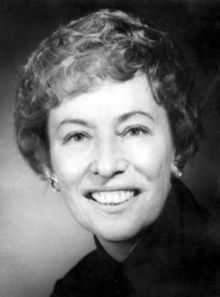Ruth Sager
| Ruth Sager | |
|---|---|
 | |
| Born |
February 7, 1918 Chicago, Illinois |
| Died |
March 29, 1997 (aged 79) Brookline, Massachusetts |
| Nationality | United States |
| Fields | Genetics |
| Known for | Pioneering cytoplasmic genetics |
| Notable awards | Gilbert Morgan Smith Medal (1988) |
Ruth Sager (February 7, 1918 – March 29, 1997) was an American geneticist.[1] Sager enjoyed two scientific careers. Her first was in the 1950s and 1960s when she pioneered the field of cytoplasmic genetics by discovering transmission of genetic traits through Chloroplast DNA,[2] the first known example of genetics not involving the cell nucleus. The academic community did not acknowledge the significance of her contribution until after the second wave of feminism in the 1970s.[3] Her second career began in the early 1970s and was in cancer genetics; she proposed and investigated the roles of tumor suppressor genes.
Life
Sager was born on February 7, 1918, in Chicago, Illinois, one of three daughters of Leon B. Sager, an advertising executive, and Deborah Borovik Sager. Following Sager's birth, her mother died from the influenza epidemic of the time. Sager and her sisters, Esther and Naomi, were raised by their step mother Hannah. At 16 Sager had graduated from New Trier High school. After, she attended the University of Chicago and earned her S.B. in mammalian physiology in 1938. Following, she attended the Rutgers University and received her M.S. in plant physiology in 1938. During World War II Sager had left academia to work as a secretary and an apple farmer. Following the war Sager had received her Ph.D. in maize genetics from Columbia University under Marcus M. Rhodes.[4] In 1944 she married Seymour Melman; in 1973 she married Arthur Pardee. She died of bladder cancer in Brookline, Massachusetts in 1997.
Education
Sager matriculated at the University of Chicago at the age of 16 and received her undergraduate degree in 1938, master's degree in plant physiology from Rutgers University in 1944, and doctorate in maize genetics under Marcus Rhoades from Columbia University in 1948. She also studied with Barbara McClintock while at Columbia.[3]
Research and career
She worked as a postdoctoral fellow at the Rockefeller Institute on the chloroplast from 1949 to 1951. From 1951 to 1955 was a staff member at the Rockefeller Institute of Medical Research, using the alga Chlamydomonas reinhardtii as a model organism. Sager's research provided evidence for non-Mendelian uniparental inheritance; it also showed that there are multiple independent genetic systems in Chlamydomonas.[2] She was a research scientist from 1955 to 1965 at Columbia.[5]
She received a faculty position in 1966, 18 years after receiving her doctorate, when Hunter College invited her to be a professor of biology.[2]
In 1975 she joined the Department of Microbiology and Molecular Genetics at Harvard Medical School as a professor of cellular genetics. Her laboratory was at the Dana-Farber Cancer Institute where she was chief of the Division of Cancer Genetics. She was elected a fellow of the American Academy of Arts and Sciences in 1979.[6] In 1988 Sagar was awarded the Gilbert Morgan Smith Medal from the National Academy of Sciences.[7]
References
- ↑ "Ruth Sager, HMS Geneticist, Dies". Harvard Gazette. April 10, 1997. Retrieved February 21, 2012.
- ↑ 2.0 2.1 2.2 "Ruth Sager: Faculty of Medicine - Memorial Minute". Harvard Gazette. November 4, 2004. Retrieved February 21, 2012.
- ↑ 3.0 3.1 Oakes, Elizabeth. International Encyclopedia of Women Scientists. 2002. Facts on File.
- ↑ Pardee, Arthur. "Ruth Sager 1918-1997" (PDF). National Academy of Science. Retrieved 27 Mar 2014.
- ↑ Biographical memoir hosted by the National Academy Press Accessed February 21, 2012.
- ↑ "Book of Members, 1780–2010: Chapter S" (PDF). American Academy of Arts and Sciences. Retrieved July 25, 2014.
- ↑ "Gilbert Morgan Smith Medal". National Academy of Sciences. Retrieved 16 February 2011.
Further reading
- Schmitt, Gail K. (1970–80). "Sager, Ruth". Dictionary of Scientific Biography 24. New York: Charles Scribner's Sons. pp. 316–321. ISBN 978-0-684-10114-9.
|